The Tokai earthquake is approaching
The Tokai earthquake is an earthquake which is most often
predicted its generating time. The energy has accumulated for about 150
years after the last Tokai earthquake happened. (Fig. 7)
If the Tokai earthquake happens now, it will become the earthquake of
a 15 times as many scale as the Hyogo southern part earthquake. The scale
of an earthquake becomes larger as generating is overdue.
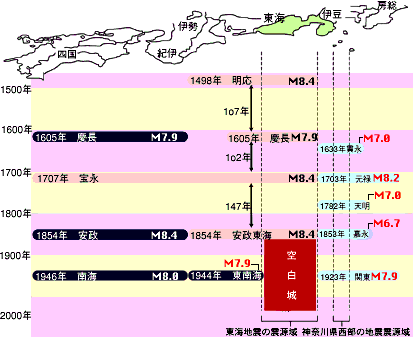 Fig. 7
Fig. 7
Around
Shizuoka prefecture, Kii Peninsula and Shikoku, the Philippine Sea Plate
is sunk and crowded with the speed of 4cm down to the Japanese Islands
every year. Therefore, the plate boundary type great earthquake has happened
every 100 to 150 years.
The great earthquake whose source region is around Shizuoka prefecture
to Omaezaki is called Tokai earthquake.
The great earthquake whose source region is around the golf of Ise to
Mie prefecture is called the southeast sea earthquake.
Tokai and the southeast sea earthquake united and happened in 1854. This
is called Ansei Tokai earthquake.
The southeast sea earthquake happened independently in 1944. This is called
Showa southeast sea earthquake. However, the "Showa Tokai earthquake"
did not happen.
147 years have passed since the last Ansei Tokai earthquake as of 2001.
It was 147 years to the Ansei Tokai earthquake from the Houei Tokai earthquake.
The energy that causes an earthquake has accumulated.
However, there are an idea "the Tokai earthquake happens independently",
and an idea of saying, "It does not happen unless the southeast sea
earthquake does" If the Tokai earthquake happens independently, "now"
will be the generating time. The energy will be 15 times of the Hyogo
southern part earthquake's one.
If it happens with the southeast sea earthquake, it will generate about
the middle of the 21st century or later. The energy in that case increases
several times comparing with the time of happening independently.
|
According to the estimate of
governmental Headquarter of Earthquake Research Promotion
announced on September 27 in 2001, the probability that the
southeast sea earthquake will occur within 30 years after
present is 40 to 50%.
Ashihama and Miyama-cho of Mie Prefecture are also contained
in the source region according to the long-term earthquake
evaluation of the Headquarter of Earthquake Research Promotion
Nankai Trough.
The
source region of an assumption Nankai earthquake and Hamaoka
earthquake
|
|
The position of the Hamaoka nuclear power
plants
The Hamaoka nuclear power plants are in right
above the assumed source region of the Tokai earthquake. (Fig. 8)
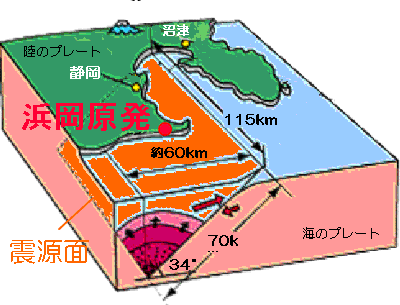 Fig.
8 Fig.
8
The focus of the earthquake is a tomographic
layer with area. The 60km x 115km whole base rock is destroyed, and it
shifts and moves at the Tokai earthquake. The shock becomes a big earthquake.
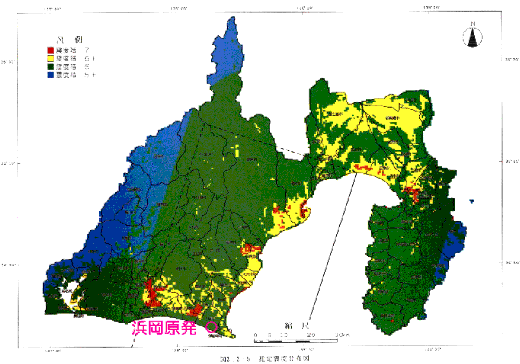 Fig.
9 Fig.
9
 Fig. 10
Fig. 10
Fig. 9 is seismic intensity
prediction of the Tokai earthquake by Shizuoka Prefecture. The position
of the Hamaoka nuclear power plants is added.
The small figure 10 is the seismic intensity in Kobe at the Hyogo southern
part earthquake. Both show seismic intensity 7 (30% or more of a building
collapses) in red.
Both of the maps are the same scales. You would recognize
the size of the scale of the Tokai earthquake.
|
Fig. 8 and Fig. 9 are based on the focus model
of Mr. Katsuhiko Ishibashi in 1976. Shizuoka Prefecture
has performed damage assumption by the Ishibashi model for
a long time.
Taking in the experience of the subsequent Hanshin Awaji
great earthquake, the damage assumption was revised upward
and announced in May 2001.
The third earthquake damage assumption of Shizuoka
On the other hand, from the accumulation of
the data for 20 years, which aimed at the forecast just
before the Tokai earthquake, the form of a plate boundary
is becoming clearer than before.
Then, the board of inquiry by 16 researchers was established
in the Central Disaster Prevention Council of the government
in 2001, and their result was released before December.
Expanding the focus tomographic layer with its 30%, the
range containing a little less than six seismic intensity
spread around Chigasaki, Suwa and Nagoya. (Fig. 10-2)
|
|
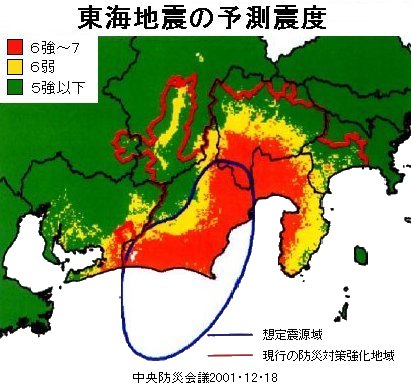 Fig
10-2 Fig
10-2
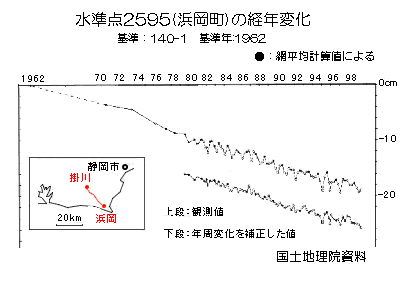 Fig
11 Fig
11
The Philippine Sea Plate has sunk in the basement in Hamaoka
at about 4cm speed per year from the southeast side to the northwest side.
Therefore, the base rock of Hamaoka is drawn in little by little. (Fig.
11)
As shown in a figure, comparing with Kakegawa of 20km inland, Hamaoka
inclined every 5mm and has fallen every year. Into a base rock, distortion
accumulates with it every year. And when a limit is reached, a base rock
is destroyed in an instant, and the land shifts and moves.
At this time, most of the old sediments will upheaval only in several
10 seconds. It is expected that the amount of upheaval becomes some 1m.
Can the nuclear power plants
of Hamaoka resist the Tokai earthquake?
It came to be thought only
30 years ago that the Pacific plate has sunk down to the Japanese Islands.
The thing of the earth is hardly understood yet. The problem is the location
of the source region of the big earthquake and whether we will able to
have the courage to accept our mistakes and stop the operation of those
plants of Hamaoka.
1976
|
The Tokai earthquake theory (Ishibashi model) was advocated.
|
1976
|
No. 1 furnace (540,000 kw) of nuclear
power plants of Hamaoka started to operate. |
1978
|
The Large-Scale Earthquake Countermeasures Act was enacted.
|
1978
|
The No. 2 furnace of the nuclear power plants of Hamaoka (840,000
kw) started to operate
|
1979
|
6 prefecture 170 cities, towns and villages of the Tokai area
was specified as an earthquake disaster-measures special strengthening
area
|
1979
|
In the United States the Three Mile Island nuclear power plant
meltdown accident happened.
|
1986
|
The conflagration evil accident of the CHIERUNOVIRI nuclear
power plant happened in the Soviet Union.
|
1987
|
The No. 3 furnace (1,100,000 kw) of the nuclear power plants
of Hamaoka started to operate.
|
1988
|
The water leaked from a nuclear reactor pressure vessel piping
welding part at the No. 1 furnace of the nuclear power plants
of Hamaoka.
|
1993
|
The No. 4 furnace (1,140,000 kw) of the nuclear power plants
of Hamaoka started to operate.
|
1995年
|
The Hanshin earthquake occured. |
2001年
|
静岡県第三次被害想定(5月)
|
2001年
|
1号炉原子炉底から水漏れ始まる(夏から・発見は11月)
|
2001年
|
東海地震震源域見直し(8月)
|
2001年
|
1号炉配管爆発事故・同じ構造の2・3号機も停止
|
2002年
|
3号機運転再開(2月7日)、1・2号機は停止中
|
They say that the important buildings of nuclear power plants were made
with 3 times intensity of building standard law, but….
The usual earthquake-proof standard is aimed at damage not
attaining to a human life, even if a building breaks. However, in a nuclear
power plant, radioactivity must not be allowed to leak.
They say that the nuclear power plants do not build
on an active fault and the surrounding active fault is investigated, but…
When a dislocation arises in the underground base rock or
the tomographic layer produced in the past moves again, its shock becomes
an earthquake.
The size of the dislocation, which worked in case of the Hyogo southern
part earthquake in 1995, is 15kmx45km. However, in Kobe, the gap has not
arrived to the surface of the earth. The dislocation that caused this
earthquake is not visible in Kobe. (Fig. 12)
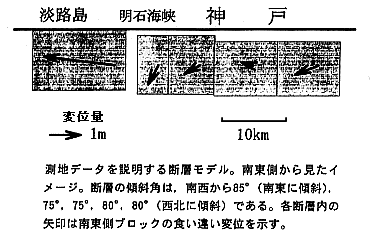 Fig.
12 Fig.
12
The active fault that is visible to surface of the earth
is only a part of dislocation group, which may cause an earthquake. In
a place where the active fault is appearing near, there is a lot of possibility
that the more dislocation invisible is underground. The active fault appears
at the place of 3 to 7km from the nuclear power plants of Hamaoka. (Fig.
13)
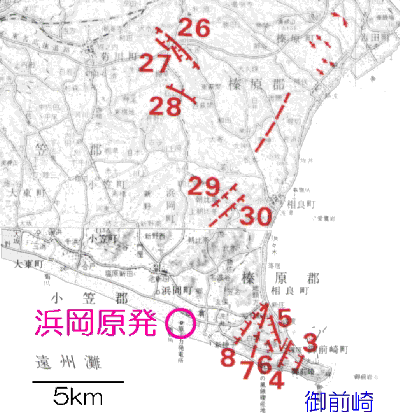 Fig.
13 Fig.
13
the nuclear power plants of Hamaoka is in the crease where
Omaezaki upheaves. There may be invisible active fault under the ground
near the nuclear power plants.
Although the Tottori western earthquake happened in
2001 was a shallow earthquake of magnitude 7.3, it occurred in the place
where the active fault was not known.
They say that it was designed to bear the biggest
earthquake, but…
The earthquake-proof design of No. 1 and No. 2 furnace assumes
the shake of an earthquake (acceleration) a maximum of 450gal. In case
of No. 3 and No. 4 furnace, 600gal for the maximum important apparatus
and 450gal for the reactor core-cooling device for emergencies, etc. As
the reason, it supposes that the shake of the Ansei Tokai earthquake in
1854 was 450gal, and the earthquake of magnitude 8.5 is a marginal earthquake
and the greatest shake by it may be 600gal. (Fig. 14, Fig. 15)
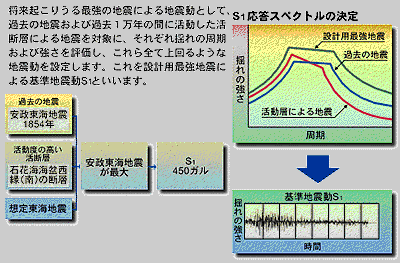 Fig.
14 Fig.
14
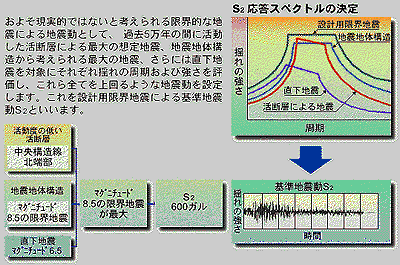 Fig.
15 Fig.
15
However, in Kobe, the shake of 800gal or more is recorded.
The 818gal in the directions of north and south, the 617gal in the directions
of east and west, and the 332gal in the vertical directions are recorded
at the Kobe Marine Observatories at the Hyogo southern part earthquake
in 1995. (Fig. 16)
600gal or more is recorded in several places. In SHIRUMA, about 900gal
is recorded in 1994 in case of North Ridge Earthquake. (Fig. 17)
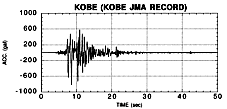 Fig.
16 Fig.
16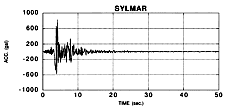 Fig.
18 Fig.
18
The design of a nuclear power plant
does not assume the shake of the Kobe average even for the maximum important
apparatus of No. 3 and 4 furnace. For the reactor core-cooling device
for emergencies only half of the shake of Kobe is assumed. In the No.
1 and 2 furnaces, which is built before a Tokai earthquake theory and
have superannuated, even for the maximum important apparatus only half
of the shake (acceleration) of Kobe is assumed.
Moreover, it is fault that the earthquakes by the active
fault which worked within the past 10,000 years (at the surface-of-the-earth
portion) are "the earthquake which may happen in the future",
and the earthquakes by the active fault which worked within the past 50,000
years (at the surface-of-the-earth portion) are "the earthquake which
is not realistic about".
A part of dislocation that caused the Mikawa earthquake in 1945 worked
for the first time in 100,000 years (at the surface-of-the-earth portion).
They say that it is constructed
directly on a hard base rock, but…
Hearing the word "a hard base rock", an ordinary
person will visualize "a hard stone." However, the foundations
of a nuclear power plant are the stratum made from sand and muddy of 4
million years ago calling the layer of Sagara and Kakegawahiki. In engineering,
it is classified into "soft rock."
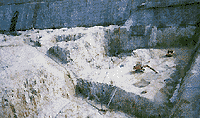 Fig
18 Fig
18
The stratum imagined with "a hard stone" is not
exposed unless in Minami-Alps. The focus model used for calculation of
a shake of a nuclear power plant is a simplified one to understand the
natural figure roughly. However, at the Tokai earthquake it is thought
that many sheets of the focus dislocations move a time lag.
In Hamaoka, which exists right above a focus tomographic layer, the seismic
waves simultaneously come from various directions. They may be amplified
intricately.
Prediction of the shake from a focus model is average value. We should
perform at maximum assumption of the nuclear power plant, which must not
break by any means.
Professor of Kobe University, Katsuhiko Ishibashi who is
the proposal person of a Tokai earthquake theory says, "
the time history and self-sustaining time of an earthquake motion in Hamaoka
must be more complicated, take more time and be far more intense than
the point of the seismic intensity 7 of the Hyogo southern part earthquake."
(The "science" 1997.10-month issue)
A seismic wave is amplified in the place where it goes into
the soft rock from a hard base rock. A seismic wave is amplified again
in the place where it goes into soft alluvium from soft rock. A seismic
wave causes amplification, reflection, refraction, and interference depending
on the underground structure.
Most structures of the deep place of underground are not known. In Kobe,
it is thought that the seismic wave was greatly amplified in some places
with the form of the hard base rock that continues from Rokkou to the
bottom of Osaka Bay. Moreover, although the strong shake continued about
for 10 seconds in Kobe, it is thought in Hamaoka at the Tokai earthquake
it will continue about 2 minutes.
They say that earthquake-proof analysis
is carried out by computer after making the model about important apparatus
and experimenting on a large-sized oscillating stand, but…
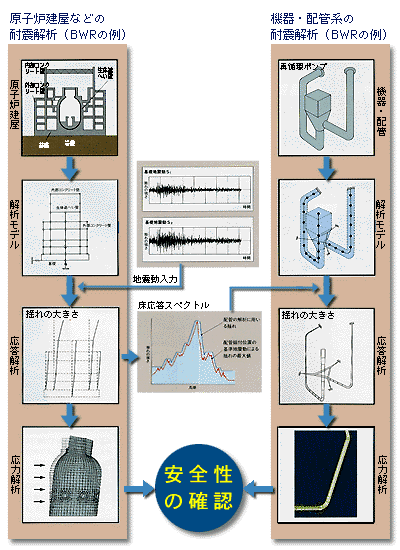 Fig 19
Fig 19
It is said that the model experiment with the vibration
of 1.5 times of the standard earthquake motion was done in No. 3 and 4
furnaces. 1.5 times is the safety margin that exceeded the error of construction,
and superannuation. It is fault that it can bear to a 1.5 times strength
by this reason.
Moreover, though each apparatus is equal to vibration, a way of shaking
is different for every apparatus. Intense power can be produced in a connection
part. If the welding part of a nuclear reactor and piping fractures, a
fearful cooling-water loss accident will be caused. Does a complicated
huge system shake as predicted?
Moreover, No. 1 and No. 2 furnaces are designed for 450gal, and superannuation
is also progressing. As they had constructed more than 20 year ago, with
a lot of neutron the nuclear reactor main part has got weak. The part
where piping is welded to the nuclear reactor main part started stress
corrosion cracking at the Hamaoka No. 1 furnace in 1988.
They are the parts that were said not to need to exchange at all to decommissioning.
There cannot be any perfect construction, either. The leak from the bottom
of a nuclear reactor was again found at the No. 1 furnace in November
2001.
Each building and apparatus have peculiar wavelength, when they vibrate.
It is said that a firm nuclear reactor building vibrates finely (periodic
0.2? 0.5 seconds). Probably the piping will vibrate slowly although it
changes with length or thickness. The low-pressure irrigation tanks of
the reactor core-cooling device for emergencies etc. will vibrate very
slowly.
If the peculiar wavelengths of apparatus and of an earthquake motion
suit, it will be amplified and big power will be added. In Kobe the things
leaped up. The thing will have been thrown if the power is added in the
vertical direction more than gravity. It is not wrong that the power exceeding
gravity acceleration (980gal) was applied.
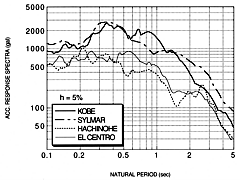 Fig
20
The figure shows the computer simulation. You can see there that in Kobe
the power exceeding gravity pressed the structure of a short oscillating
cycle (0.15 to 1.2 second), and the very big power exceeding the twice of
gravity has brought at the maximum. Fig
20
The figure shows the computer simulation. You can see there that in Kobe
the power exceeding gravity pressed the structure of a short oscillating
cycle (0.15 to 1.2 second), and the very big power exceeding the twice of
gravity has brought at the maximum.
The shake out of assumption is discovered at every damage
earthquake.
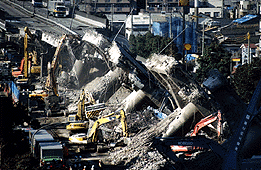 Fig
21 Fig
21
The highway fell down at
the North Ridge Earthquake, which happened in Los Angeles suburbs early
in the morning of January 17, 1994. Immediately after that, the Japanese
government declared that as Japanese highways standard was different;
there was no problem here.
Early in the morning of January 17, 1995, exactly one year after that,
in Kobe the elevated roads of the Shinkansen and highways fell down, too.
It was exactly "the shake out of assumption" In fact; the shake
800gal or more is recorded also like Kobe's one at the North Ridge Earthquake.
(Fig. 17)
Also in the Nagano western earthquake in 1984, the marks of a jump stone
phenomenon were found and it was presumed that the power exceeding gravity
acceleration was applied. Probably, there was the same shake also in the
past earthquake. Only men could not measure it. In the Niigata earthquake
in 1964, liquefaction took place and the apartment fell.
At the Tokachi earthquake in 1968, the pillar of ferro-concrete broke
and the first floor of a university building was crushed by perpendicular
power. At the central Sea of Japan earthquake in 1983, it turned out that
there was a way of shaking of long cycle vibration. At the North Ridge
Earthquake in 1975, and the Hyogo southern part earthquake in 1976, the
almost same earthquake motion as gravity acceleration was observed.
What shake out of assumption will be discovered at the Tokai earthquake?
|